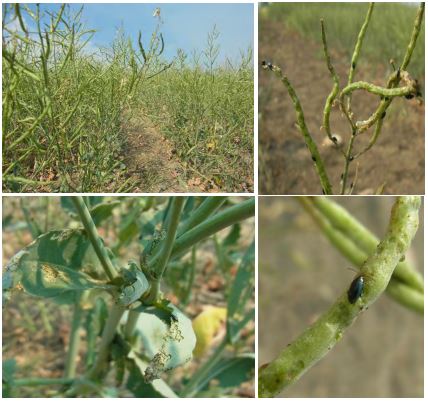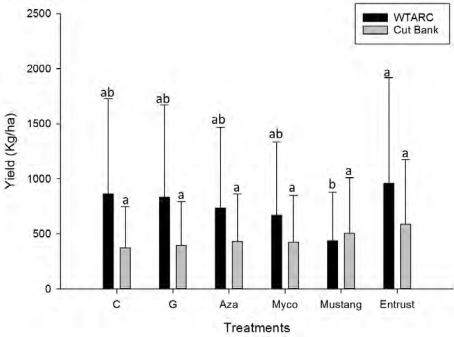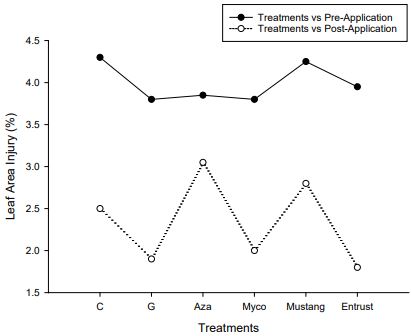Evaluation of commercially available bio-pesticides against crucifer flea beetles and cabbage seed pod weevils on canola
Principal Investigator: Gadi V.P. Reddy1
Project Personnel: Anamika Sharma1, John H. Miller1, and Julie Prewett1
1Western Triangle Agricultural Research Center, Montana State University, Conrad, MT
Aim of the study
The aim of the study was to test the impact of three bio-pesticides: 1) Mycotrol ESO® (Beauveria bassiana GHA), 2) Aza-Direct® (azadirachtin) and 3) Entrust WP® (spinosad 80%) in comparison to two conventional insecticides, Gaucho® (imidacloprid) and Mustang Maxx® (Zeta-cypermethrin) on crucifer flea beetles (Phyllotreta cruciferae) and cabbage seed pod weevils (Ceutorhynchus obstrictus) on canola.
Figure 1. Flea beetle feeding damage on Canola at Conrad in 2018.
Material and Methods Study sites
Field trials were conducted at two locations in Conrad (48o 18.627’N, 111o 55.402’ W) at the Western Triangle Agricultural Research Center research field area and Cut Bank (48o 30.77’N, 111o 92.55’ W), both representing dryland rain fed (i.e., non-irrigated) conditions of the West-
Central region of Montana, USA in 2018. Both the sites were sown with canola in 2017. Experimental plots were seeded on May 2, 2018 (Conrad) and June 7, 2018 using Hy-Class® (WindField Solutions, LLC, Houston, Texas) cultivar at a rate of 12 seeds per 30 cm, using a four- row plot drill with 30 cm row-row spacing. At Conrad, round-up ready canola was seeded and at Cut Bank Cibus canola was seeded. Weed control was done by pre-plant application of herbicide RT3® (a.i. glyphosate) at a rate of 2.5 L/ha.
Experimental design and application
The field experiments at both the locations were Randomized Complete Block Design (RCBD). Individual plots measured 3.6 m × 1.2 m in size at Cut Bank and 6 m × 1.2 m in size at Conrad. A buffer zone of 1.2 m was set up between each plot to avoid cross contamination due to spray drift. Treatments were replicated 4 times at each location. Gaucho was applied as seed treatment and other treatments were applied as foliar application after first incidence of flea beetle. Since plot size is different for both sites, the application rate were calculated accordingly (Table 1). Each plot was rated for the flea beetle (P. cruciferae) feeding injury along one 3.6-m section of row in each plot, by sampling 10 plants at 0.3 m intervals, four times i.e. cotyledon, four leaf, pre-flowering and pod formation stage during the canola growing season. Phyllotreta cruciferae injury measurements were made by visual examination, on a 5-grade scale as defined in OEPP/EPPO (2004). The visual injury ratings were converted into percent leaf area injury, where 1 = 0%; 2 = 2%; 3 = 5%; 4 = 10%; and 5 = 25% injury to the leaf area. Seedpod weevil (SPW) damage assessments on the pods were performed at the canola pod maturation stage. Fifteen pods were randomly sampled per plot and damaged or undamaged pods were determined in the lab by visual inspection using SPW damage characteristics (Feeding holes) followed by the opening of pods with a sharp blade to check the presence of larvae inside the pods.
Post-harvest data collection
The canola plots were straight combined stored and air dried until the seeds were at 10% moisture. The seeds were then cleaned and weighed to determine the seed yield followed by the assessment of canola grain quality parameters including test weight, thousand kernel weight (TKW) and percent oil content. Before harvesting, the plot’s areas were calculated. After harvesting, canola from each plot were brought to the WTARC facility and cleaned using a seed cleaning machine (Almaco, Allan Machine Company, Iowa, USA). The plot and test weight was measured using a laboratory balance (Ohaus, Adventure™ Pro model AV8101). Canola samples were processed through a grain analyzer (Perten Instruments IM9500; Hägersten, Sweden) to determine moisture, and oil content.
Statistical analysis
PROC MIXED procedure (PROC MIX, SAS Institute 2018) was performed for determining the effects of conventional insecticides and biopesticides on P. cruciferae injury damage ratings and, yield and grain quality parameters including test weight, and percent oil content. An alpha level of
0.05 was used for all tests. Since, effect of pesticides was not significant, least square (LS) mean estimates and their SE are presented for main effects only.
Table 1: Materials and rates of application in each treatment applied on Canola in 2018 at two sites.
|
Treatment |
Active Ingredient |
Concentration |
Rate |
Source |
|
Control |
Water |
|
|
|
|
Gaucho® 600 Seed treatment |
Imidacloprid |
190 ml/45 kg seed |
190 ml/45 kg seed |
Bayer Crop Science |
|
Aza-Direct® |
Azadirachtin |
1.43 ml/L (473 ml/acre) |
1.43 ml/L |
Gowan Company |
|
Mycotrol® ESO |
Beauveria bassiana Strain GHA |
237-950 ml/gallon 62-250 ml/liter |
1.25 ml/litre |
LAM International |
|
Mustang Maxx® |
Zeta-cypermethrin |
118.294 ml/acre |
0.028 ml/litre |
FMC corporation |
|
Entrust® |
Spinosad (a mixture of spinosyn A and spinosyn D) |
0.091 ml/L of water 0.34352 ml/ gallon |
0.091 ml/L of water |
Dow AgroSciences |
Table 2: Crucifer flea beetle leaf area feeding injury (LS means estimates ± SEM) to canola seedlings treated with biopesticides and chemical seed treatment in Montana. a and b Injury ratings pre foliar and 15 days after foliar application, respectively. Mean differences among the treatments are based on LSD (0.005).
|
Treatment |
WTARC |
Cut Bank |
||||
|
|
Leaf Area Injury pre- treatment |
Leaf Area Injury post 15 days treatment |
Yield |
Leaf Area Injury pre- treatment |
Leaf Area Injury post 15 days treatment |
Yield |
|
Water |
4.3±0.2a |
2.5±0.4ab |
864±140ab |
1.2±0.08c |
- |
374±90a |
|
Imidacloprid |
3.8±0.2a |
1.9±0.4ab |
834±140ab |
1.2±0.08a |
- |
397±90a |
|
Aza-Direct |
3.85±0.2a |
3.05±0.4a |
734±140ab |
1.3±0.08bc |
- |
432±90a |
|
Mycotrol |
3.8±0.2a |
2±0.4ab |
668±140ab |
1.4±0.08abc |
- |
425±90a |
|
Zeta-cypermethrin |
4.25±0.2a |
2.8±0.4ab |
439±140b |
1.3±0.08bc |
- |
506±90a |
|
Entrust |
3.95±0.2a |
1.8±0.4b |
959±140a |
1.45±0.08ab |
- |
587±90a |
|
F, P |
0.6 (0.3) |
1.2 (0.2) |
425 (0.2) |
0.2 (0.1) |
- |
274 (0.5) |
|
Treatment |
WTARC |
Cut Bank |
||||
|
|
Oil Content (%) |
Test Weight (lbs/bu) |
TKW (gms) |
Oil Content (%) |
Test Weight (lbs/bu) |
TKW (gms) |
|
Water |
45±0.42a |
46±0.61b |
1.5±1.7b |
45±0.65a |
48±1.4a |
2.2±1.4b |
|
Imidacloprid |
44.6±0.42a |
47±0.61ab |
2.5±1.7b |
43±0.65b |
48±1.4a |
3.6±1.4ab |
|
Aza-Direct |
44.7±0.42a |
48±0.61ab |
3.4±1.7b |
44±0.65ab |
49±1.4a |
2±1.4b |
|
Mycotrol |
44±0.42a |
48±0.61ab |
2.5±1.7b |
44±0.65ab |
48±1.4a |
4±1.4ab |
|
Zeta-cypermethrin |
45±0.42a |
48.5±0.61a |
9.2±1.7a |
44±0.65ab |
48±1.4a |
5.7±1.4ab |
|
Entrust |
45±0.42a |
47±0.61ab |
2.5±1.7b |
44±0.65ab |
48±1.4a |
7.7±1.4a |
|
F, P |
1.2 (0.67) |
1.8 (0.24) |
4.6 (0.02) |
1.9 (0.3) |
0.9 (0.6) |
4.2 (0.08) |
Results
At both the sites in 2018, no cabbage seed pod weevil was observed. Flea beetle injury at both the sites were recorded before applying treatment. At Cut Bank site, after spraying few flea beetles were observed throughout all the plots with no injury to the plants. A significant decrease in pod and leaf injury was recorded in the Entrust treated plots (F=1.2, df=15; P=0.2) at WTARC site. Almost negligible effect on flea beetle injury level were observed in the plots treated with Aza- Direct (Table 2). In terms of yield at WTARC site, Entrust had significant positive impact on yield (F=425; df=15; P= 0.2). At Cut Bank due to late harvesting and hail damage the yield was less (Figure 2).
Conclusion
At both the sites no cabbage seed pod weevil (Ceutorhynchus obstrictus) was noticed on Canola. The flea beetle (Phyllotreta cruciferae) damage was not noticed at Cut Bank after application of treatments. At WTARC site, post application of treatment there was an overall reduction in population of flea beetles (Figure 3). However, the best treatment which reduced the damage to canola crop and overall increased the yield. Curiously, greater TKW (thousand kernel weight) was noticed in Mustang treated plots at WTARC and Entrust treated plots at Cut Bank. Although at Cut Bank no significant difference was observed in yield but still greater yield was noticed in Entrust treated plots. Entrust seems to work best in terms of reducing the flea beetle population and also in increasing the yield. In the present study we have applied the treatments only once, and flea beetle infestation was extremely heavy at two cotyledon stage as well as pod stage at WTARC site. In spite of both the factors, Entrust gave a good protection against flea beetle at WTARC.
Figure 2. Mean yield (kg/ha) of canola at two sites, WTARC and Cut Bank in 2018. [n =4]. Different letters above the bars indicate significant differences (α= 0.05). y-axis shows mean yield (mean yield+ SE) and x-axis indicate six treatments.
Figure 3. Leaf area injury on canola at WTARC in 2018. Leaf area injury pre-treatment application ( ) and post-treatment application ( ). [n = 4]. Difference were analyzed between treatments at α= 0.05. y-axis shows leaf area injury (%) and x-axis indicates six treatments.
Acknowledgements
This work was supported by Montana Wheat and Barley Committee. We would like to thank summer interns Mikayla Connelly and Carley Ries for assistance with field work. We would thank the producers, Todd Eney and Phil Ascham for providing the fields to establish experiment.
References:
OEPP/EPPO. 2004. Efficacy evaluation of insecticides. Phyllotreta spp. On rape, pp. 242-244. OEPP/EPPO Bull. Pp 1/218.
SAS Institute Inc. 2018. 9.4 In-Database Products, User’s Guide, fifth ed. SAS Publishers, Cary, NC, USA.



